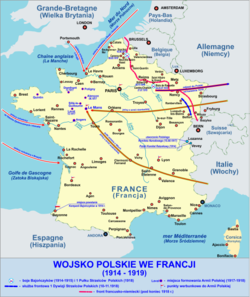| Blue Army Haller's Army | |
|---|---|
| Błękitna Armia Armée bleue | |
 General Józef Haller swearing for the Polish flag when he was nominated to command the Blue Army, c. 1918 | |
| Active | 1917–1919 |
| Country | |
| Allegiance | Entente Powers Whites (anti-Bolsheviks) |
| Branch | Polish Legions |
| Size | 68,500 |
| Engagements | World War I Polish–Ukrainian War Polish–Soviet War |
| Commanders | |
| General | Józef Haller von Hallenburg |
| General | Louis Archinard |

The Blue Army (Polish: Błękitna Armia; French: Armée bleue), or Haller's Army, was a Polish military contingent created in France during the latter stages of World War I. The name came from the French-issued blue military uniforms worn by the soldiers. The symbolic term used to describe the troops was subsequently adopted by General Józef Haller von Hallenburg to represent all newly organized Polish Legions fighting in western Europe.
The army was formed on 4 June 1917, and was made up of Polish volunteers serving alongside allied forces in France during World War I. After fighting on the Western Front, the army was transferred to Poland, where it joined other Polish military formations fighting for the return of Poland's independence. The Blue Army played a pivotal role in ensuring Polish victory in the Polish–Ukrainian War. Later Haller's troops took part in Poland's defeat of the advancing Bolshevik forces in the Polish–Soviet War.